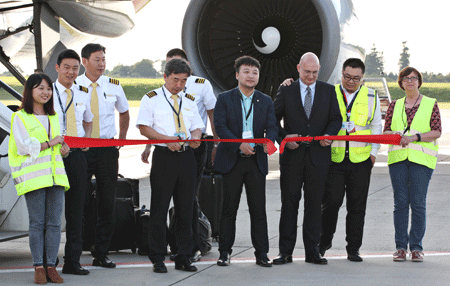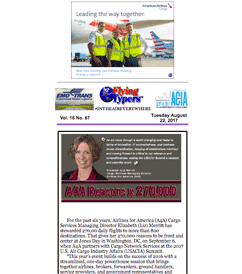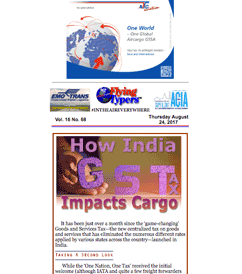
 |
 |
 #INTHEAIREVERYWHERE |
| Vol. 16 No. 70 | Thursday
August 31, 2017 |
 Where
in the world is air cargo pioneer and educator who among other things forged
and established the Sea-Air business in Dubai? Where
in the world is air cargo pioneer and educator who among other things forged
and established the Sea-Air business in Dubai?There he is . . . say hello to (right) Issa Baluch, Senior Advanced Leadership Fellow at Harvard University, Chairman, FIATA Logistics Academy in the picture with (center) The Hon. Sharif Hassan Sheik Aden, President of the South West State of Somalia (center), and (left), Professor Wesley Harris, Charles Stark Draper Professor and Head, Department of Aeronautics and Astronautics, Massachusetts Institute of Technology In addition to addressing strategies that would allow logistics to help reverse trade imbalances, Mr. Baluch has also been involved in agriculture projects in Africa aimed at addressing food shortages. Next stop for Issa is a series of panels in Kuala Lumpur, where FIATA is holding its World Congress beginning October 4. |
Smart
Marketing Alternative Facts or Faked News? Tales Of Greenland When Erik
returned to Iceland after his exile had expired, he is said to have
brought with him stories of a “Greenland.” Going Green Follows All of
this said, there is no denying that the Nordic people can gaze back
proudly at a long, legendary history of “going green.” MORE Inconvenient Truth Emerging As that
famous Al Gore film underscored, we humans are polluting our planet
and emitting too much Green House Gases (GHG) and CO2 into the atmosphere,
thereby contribution to global warming. The Nordic countries have taken
the issue very seriously. What Role For Transportation? The transport
challenge was taken to heart as well.
Gasless
Norway Ahead SJF Airports As you
read this, Avinor is one of the first airport companies in the Nordic
countries—together with Stockholm’s Arlanda airport in Sweden—to
already offer a blend-in of Sustainable Jet Fuels (SJFs) to their customers
at Oslo Gardemoen Airport. Needless To Say, Say It Anyway In the
meantime, the EU has imposed strict limits on CO2 emissions (a 40 percent
emission reduction by 2030 compared to 1990). Greener Nordics So just
like many other countries in the EU and around the globe, numerous green
initiatives were initiated in the Nordic countries to create societies
that would help reduce GHG/CO2 emissions, lower pollution, and create
a cleaner as well as a healthier environment.
The first
of a series of Green Aviation Days at Copenhagen Airport was organized
in 2012. The events took place in the old, historic passenger terminal,
which was built in 1939 and designed by one of our great architects,
Wilhelm Lauritzen.
The different stakeholders
in this category of aviation, including “future” passengers—young
school kids—have attended these events.
Techno SJFs As described
in my previous article, we have several technologies available for the
production of SJFs—alternative jet fuels—and many more shall
be available during the coming decades.
Certification Mandatory ATAG and
IATA estimate that over time and with 100 percent use of SJFs, an 80
to 90 percent reduction in GHG emission will be achievable.
Looking ahead,
we can only hope that the day will dawn wherein as a result on innovation
and determination, aviation contributes to reducing—and hopefully
even reversing—global warming as well as extreme weather conditions.
Even More Reading
For further details and in-depth facts on the technical aspects of SJFs
and the complete information on this matter, check out the Nordic
Report (Sustainable jet fuels for aviation) as well as the cooperation
on SJFs in the Nordic countries through the Nordic Council and the Nordic
Energy Ministers.
In the next installment of this exclusive FlyingTypers series on sustainable aviation, FlyingTypers together with various stakeholders in the Nordic countries will cover some of the specific initiatives taken to advance SJFs in this part of the world, including the cooperation on SJFs through the Nordic Council and the Nordic Energy Ministers. We will also examine developments amongst facilitators, producers, airports, and airlines as well as various organizations that altogether make it possible for this region to lead the way in aviation future challenges for a sustainable environment. Your comments are welcome. Robert Arendal To read Part 1 of this series–Long Road To Tomorrow, Click here.
|
 Happy Faces—Going Places . . . Suparna Airlines opened services this week at Frankfurt-Hahn Airport in Germany, formally launching a new cargo route Xi’an-Hahn-Erdos. On August 9, 2017 China based HNA Group purchased 82.5% of Frankfurt-Hahn Airport. “The Hahn” located in the heart of Europe, looms large in the HNA Group’s plan to utilize airline logistics as key to constructing a new “Silk Road”. Stay tuned . . . |
|
|
Why
Attend |
|
 |
  In
Frankfurt On August 24 nearly 1,000 runners participated in a fund-raising
event organized by Cargo Human Care. The net proceeds will go towards funding
the construction of a preschool for 100 children in an impoverished neighborhood
of Nairobi. In
Frankfurt On August 24 nearly 1,000 runners participated in a fund-raising
event organized by Cargo Human Care. The net proceeds will go towards funding
the construction of a preschool for 100 children in an impoverished neighborhood
of Nairobi.Fokko Doyen (pictured in Nairobi with the children), founder and first Chairman of Cargo Human Care, said, “Our aim with the Happy Children Education Center is to provide the poorest children in one of Nairobi’s slums with the opportunity of a secure preschool education.” This is the third year this event has taken place. More than 100 Lufthansa Cargo staff ran the five to ten kilometer course. The Lufthansa Cargo Executive Board contributed further matching the entry fees of their staff. The running teams also included customers and service providers of the Lufthansa Group’s cargo subsidiary, and various other divisions of the Lufthansa Group. |
 |
If
You Missed Any Of The Previous 3 Issues Of FlyingTypers Access complete issue by clicking on issue icon or Access specific articles by clicking on article title |
||
 Vol.
16 No. 67 Vol.
16 No. 67A4A Reasons x 270,000 Chuckles for August 22, 2017 Can China-Europe Cargo Stay On Track? Letters to the Editor The Fixer At American Airlines Cargo Stamp Of A Total Eclipse Of The Sun |
 Vol.
16 No. 68 Vol.
16 No. 68How India GSTax Impacts Air Cargo Chuckles for August 24, 2017 Trump Effect Pt. 7 Rewarding Experience From Capetown To Eindhoven |
|
Publisher-Geoffrey
Arend • Managing Editor-Flossie Arend Film Editor-Ralph Arend • Special Assignments-Sabiha Arend, Emily Arend • Advertising Sales-Judy Miller |
|